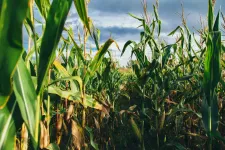Adaptation, not irrigation recommended for Midwest corn farmers
2021-03-09
(Press-News.org) Farmers in the Midwest may be able to bypass the warming climate not by getting more water for their crops, but instead by adapting to climate change through soil management says a new study from Michigan State University.
"The Midwest supplies 30% of the world's corn and soybeans," said Bruno Basso, an ecosystems scientist and MSU Foundation Professor in the Department of Earth and Environmental Sciences within the College of Natural Science. "These crops are sensitive to temperature and water changes."
Previous studies have suggested that by 2050, the Midwest will need about 35% more water to sustain its current levels of corn and soybean yields. But research done by Basso and colleagues found that the data does not support this idea. The Midwest is in a unique location that typically receives ample rainfall and has deep soil, ideal for farming.
The research was published March 5 in Nature Communications.
Basso, with his lab members Rafael Martinez-Feria and Lydia Rill, and MSU Distinguished Emeritus Professor Joe Ritchie, analyzed climate trends from weather stations from across the Midwest dating as far back as 1894.
The researchers found that average daily temperatures during the summer have increased throughout much of the Midwest. But they also discovered that daily minimum air temperatures, usually during the nighttime, have increased while the daily maximum daytime temperatures have decreased.
These trends held true during the full, 120-year weather record studied or during more 30- to 60-year time periods.
"Warmer temperatures generally mean that crops need more water, but that doesn't seem to be the case in the Midwest," said Basso, who is also a faculty member at MSU's W.K. Kellogg Biological Station and AgBioResearch. "Because the increase in average temperature comes from higher minimum temperatures -- the temperature at which dew is formed -- this means that the air is also becoming more humid."
Ritchie, one of the co-authors on the study, said that these two contrasting trends have canceled each other out, and that so far, the potential crop water demand has remained relatively unchanged despite the warming climate.
Data were entered into computer simulation models developed at MSU by Basso and Ritchie to gauge the impact if these trends continued into 2050. Martinez-Feria, another co-author on the study, said that in the worst-case scenario, the amount of water needed by crops could increase by an average of 2.5%. More conservative estimates indicate that water needs would remain practically the same, because summer rainfall would also increase.
Basso cautions that although crop water needs may be similar in the future, increasing air temperatures also make droughts more likely to occur. "The impact climate change will have on the Midwest is still uncertain," he said. "We are still at risk of droughts."
But instead of installing extensive and expensive irrigation systems that might only pay off under extreme droughts, Bassos advises farmers to invest in technology and regenerative soil practices that make plants more resilient and adaptable to climate change.
"As we continue to learn more about weather and its increased variability, farmers need to adapt, which they are starting to do," Basso said. "I feel optimistic that with the progress made in regenerative practices, genetics and digital technology solutions, we can adapt to climate and have a better chance of winning this battle against our own previous mistakes."
INFORMATION:
[Attachments] See images for this press release:

ELSE PRESS RELEASES FROM THIS DATE:
2021-03-09
If past natural disasters have taught us anything about their effects on pregnant women and developing babies, it is to pay close attention, for the added stress will surely have an impact on them. Amanda Venta, associate professor of psychology at the University of Houston, is sounding that alarm as it relates to the COVID-19 pandemic in a newly released study published in Child Psychiatry & Human Development.
"There is strong evidence to suggest that the coronavirus pandemic will affect mothers and infants through immune pathways that, in previous research, have been shown to link stress and social isolation during the pre- and post-natal periods with deficits in maternal mental health and infant well-being and development across developmental stages," reports Venta.
Research ...
2021-03-09
The relationship between the Hawaiian bobtail squid and the bioluminescent bacteria living in its light organ has been studied for decades as a model of symbiosis. Now researchers have used a powerful chemical analysis tool to identify a small molecule produced by the bacteria that appears to play an important role in their colonization of the light organ.
The study, published March 9 in the journal mBio, adds a new wrinkle to scientists' understanding of the chemical signaling involved in this iconic symbiotic relationship. "It's exciting that there are still new things to discover, even in such a well-studied system," said corresponding author Laura Sanchez, associate professor ...
2021-03-09
A new systematic review of evidence recommends the use of behavioral self-management treatments for common urinary issues experienced by upwards of 70 percent of older men. Common symptoms include trouble urinating, increased frequency and incontinence. These symptoms can have a substantial negative impact on sleep, social functioning and quality of life. Several guidelines recommend self-management techniques like health education, advice on fluid intake, and bladder retraining; however, in practice, self-management is often excluded from the menu of treatment options that include medication and surgery.
Researchers at Bond University's Institute for Evidence-Based Healthcare found that self-management interventions reduced the severity of lower urinary tract symptoms. The ...
2021-03-09
Wormholes play a key role in many science fiction films - often as a shortcut between two distant points in space. In physics, however, these tunnels in spacetime have remained purely hypothetical. An international team led by Dr. Jose Luis Blázquez-Salcedo of the University of Oldenburg has now presented a new theoretical model in the science journal Physical Review Letters that makes microscopic wormholes seem less far-fetched than in previous theories.
Wormholes, like black holes, appear in the equations of Albert Einstein's general theory ...
2021-03-09
A mobile app designed to help women manage urinary incontinence was as effective as usual, in-person treatment of incontinence in primary care, according to new research from the Netherlands. The study included 262 women with frequent stress incontinence, overactive bladder or a mix of symptoms. Participants were randomly assigned to use a standalone mobile app called URinControl, which offered pelvic floor muscle and bladder training exercises. Those in a control group received standard care and were referred to their own primary care doctors who were broadly advised to follow the Dutch guidelines for primary care. After four months, ...
2021-03-09
Since the early 2010s, ultrafast probing of materials at atomic-level resolution has been enabled by terahertz scanning tunneling microscopes (THz-STM). But these devices can't detect the dissipation of energy that happens during events such as when photons are emitted via recombination process of an electron-hole pair in a light emitting diode (LED). However, a new technique allows the tracking of just such energy dynamics alongside THz-STM, opening up new avenues of investigation for nanoscale science and technology.
Researchers in Japan have developed a microscopy technique that combines the ability to manipulate the motion of electrons on a femtosecond timescale ...
2021-03-09
According to two national surveys by researchers at the University of Michigan Medical School, US teens and young adults are engaged in the ongoing COVID-19 pandemic with most being knowledgeable about the disease, concerned about its impacts on others, and practicing social distancing. On March 6, 2020, 70 percent reported knowledge of the pandemic, with 46 percent noting they got information from news sources. By March 20, 2020, nearly all respondents, 95 percent, reported impact. Worry about the pandemic increased from 25 to 51 percent. For some young people who weren't worried early on about the pandemic, staying at home and engaging in other preventive public health guidelines made them feel safer. Between the two surveys, pandemic preparation seemed to shift. ...
2021-03-09
Evidence published in the Cochrane Library today will reassure people who want to stop smoking that quitting for at least 6 weeks may improve their mental wellbeing, by reducing anxiety, depression, and stress. People's social relationships are unlikely to suffer if they stop smoking.
Smoking is the world's leading cause of preventable illness and death. One in every two people who smoke will die of a smoking-related disease unless they quit. Some people believe that smoking helps reduce stress and other mental health symptoms, and that quitting smoking might make their mental health problems worse. People who smoke may also worry that stopping smoking will have a negative impact on their social lives and friendships.
The review found that people who stopped smoking for at least 6 weeks ...
2021-03-09
CHAPEL HILL, NC -- Calling the U.S. Preventive Services Task Force's newly released recommendation statement to expand eligibility for annual lung cancer screening with low-dose computed tomography a step forward, UNC Lineberger Comprehensive Cancer Center researchers say future changes should address equity and implementation issues.
In an editorial published in JAMA, Louise M. Henderson, PhD, professor of radiology at UNC School of Medicine, M. Patricia Rivera, MD, professor of medicine at UNC School of Medicine, and Ethan Basch, MD, MSc, the Richard M. Goldberg Distinguished Professor in Medical Oncology and chief of oncology at the UNC School of Medicine, outlined their concerns and offered potential approaches to make the screening recommendation ...
2021-03-09
Researchers have come up with a better way to test which fabrics work best for masks that are meant to slow the spread of COVID-19. By testing those fabrics under conditions that mimic the humidity of a person's breath, the researchers have obtained measurements that more accurately reflect how the fabrics perform when worn by a living, breathing person.
The new measurements show that under humid conditions, the filtration efficiency -- a measure of how well a material captures particles -- increased by an average of 33% in cotton fabrics. Synthetic fabrics performed poorly relative to cotton, and their performance did not improve with humidity. The material from medical-procedure masks also did not improve with humidity, though it performed ...
LAST 30 PRESS RELEASES:
[Press-News.org] Adaptation, not irrigation recommended for Midwest corn farmers



